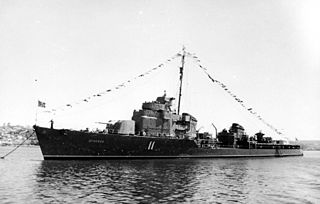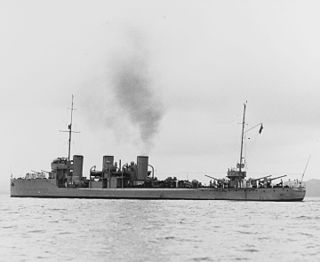
The Svetlana-class cruiser was the first class of light cruisers built for the Imperial Russian Navy (IRN) during the 1910s. Construction was interrupted by World War I, the Russian Revolution and the Russian Civil War. Only Svetlana of the quartet was completed by the Soviet Union as a cruiser, two were converted to oil tankers, and the remaining ship was scrapped without being completed.

The Bogatyr class were a group of protected cruisers built for the Imperial Russian Navy. Unusually for the Russian navy, two ships of the class were built for the Baltic Fleet and two ships for the Black Sea Fleet.

The Ognevoy-class destroyers consisted of 26 destroyers built for the Soviet Navy during and immediately after World War II. The official Soviet designation was Project 30 and Project 30K. Construction was disrupted by the invasion of the Soviet Union in 1941 and many ships were cancelled or scrapped. Only a single ship was completed during the war and the other 10 were finished in 1947–1950.

Novík was a destroyer of the Russian Imperial Navy and Soviet Navy, commissioned in 1913 where she served with the Baltic Fleet during World War I. She joined the Bolsheviks in November 1917 and was renamed Yakov Sverdlov in 1923. She was a training ship when Operation Barbarossa began, but was recalled to active duty the following day. She struck a mine on 28 August 1941 and sank while escorting an evacuation convoy during the Soviet evacuation of Tallinn.

The Derzky or Bespokoiny-class destroyers was a class of destroyers built for the Imperial Russian Navy just before World War I. Nine ships were built for the Black Sea Fleet. These ships were a derivative of the Novik, but were slightly smaller. These ships were popular with the Russians and effective particularly in the Black Sea, where the Ottoman Navy had no similar ships.

The Orfey-class destroyers were built for the Baltic Fleet of the Imperial Russian Navy. They were modified versions of the earlier destroyer Novik and the Derzky-class destroyers. These ships were larger, had triple torpedo tubes and an extra 102 mm (4 in) gun. One ship, Engels, was fitted with a 305 mm (12 in) recoilless rifle for testing in 1934. Fourteen ships were completed in 1914–1917 and fought in World War I and during the Allied intervention in the Russian Civil War. The survivors fought in World War II.

The Fidonisy class, also known as the Kerch class, were a group of eight destroyers built for the Black Sea Fleet of the Imperial Russian Navy during World War I. They participated in World War I, the Russian Civil War, and World War II.
The Izyaslav class were a class of destroyers built for the Baltic Fleet of the Imperial Russian Navy. They were modified versions of the Orfey class built in Russia with the assistance of the French company Augustin Normand. These ships fought in World War I, the Russian Civil War, the Estonian War of Independence, and World War II.

Izumrud was a protected cruiser of the Imperial Russian Navy, and the lead ship in the two-ship Izumrud class. Izumrud and her sister ship Zhemchug were based on the German-built Novik.

BAP Almirante Guise was a destroyer that served in the Russian, Estonian, and Peruvian navies from 1917 to 1954. She was a rebuilt type of the Izyaslav class. Originally named Avtroil while in Russian service, in 1918 she was captured by Royal Navy and handed over to Estonia where she was renamed Lennuk. The ship participated in the Estonian War of Independence, and served with the Estonian Navy until 1933, when she was sold to Peru where she was renamed Almirante Guise.

Tbilisi was one of six Leningrad-class destroyer leaders built for the Soviet Navy during the 1930s, one of the three Project 38 variants. Completed in 1940, the ship was assigned to the Pacific Fleet, with which she spent World War II. Tbilisi laid minefields outside Vladivostok early in the war and during the Soviet–Japanese War transported naval infantry in preparation for an amphibious landing in Korea. Postwar, she continued to serve with the Pacific Fleet and began a lengthy overhaul in 1951 that lasted until 1955. Converted into a target ship in 1958, she was finally struck from the Navy List in 1964 and scrapped.

Dzerzhinsky (Дзержинский) was one of eight Fidonisy-class destroyers built for the Imperial Russian Navy during World War I. She was originally named Kaliakria (Калиакрия) before she was renamed Dzerzhinsky in 1926.

Zheleznyakov was one of eight Fidonisy-class destroyers built for the Imperial Russian Navy during World War I. She was originally named Korfu (Корфу) before she was renamed Petrovsky (Петровский) in 1925 and Zheleznyakov (Железняков) in 1939 after anarchist Anatoli Zhelezniakov.
Izyaslav was the lead ship of her class of five destroyers built for the Russian Imperial Navy during the 1910s. Completed during 1916, she served with the Baltic Fleet during the remainder of the First World War, and after the October Revolution joined the Bolshevik Red Fleet. She was active during the Russian Civil War, taking part in several engagements against British ships during the British campaign in the Baltic. The destroyer was renamed Karl Marx in 1922. She played a small role in the Winter War with the Soviet Baltic Fleet when Germany invaded the Soviet Union in 1941, and was sunk by German aircraft on 8 August 1941.

Orfey was the lead ship of her class of eight her class of eight destroyers built for the Russian Imperial Navy during World War I. Completed in 1916, she served with the Baltic Fleet, but suffered turbine damage in late 1917, and was laid up for the rest of the war. The ship was not repaired by the Soviets and was scrapped in 1931.

Letun was one of eight Orfey-class destroyers built for the Russian Imperial Navy during World War I. Completed in 1916, she served with the Baltic Fleet during the war, but struck a naval mine in October that crippled her. The ship was under repair in Reval, Estonia, when the Soviets evacuated the city. Abandoned, Letun was broken up for scrap in 1927.

Samson was one of eight Orfey-class destroyers built for the Russian Imperial Navy during World War I. Completed in 1916, she served with the Baltic Fleet and joined the Bolshevik Red Fleet after the October Revolution of 1918. She was active during the Russian Civil War, taking part in several engagements against British ships during the British campaign in the Baltic. The destroyer was renamed Stalin in 1922. She was assigned to the Pacific Fleet when Germany invaded the Soviet Union in 1941 and saw little to no combat. The ship was scrapped in 1953.

Desna was one of eight Orfey-class destroyers built for the Russian Imperial Navy during World War I. Completed in 1916, she served with the Baltic Fleet and joined the Bolshevik Red Fleet after the October Revolution of 1918. She was active during the Russian Civil War, taking part in several engagements against British ships during the British campaign in the Baltic. The destroyer was renamed Engels in 1922. She remained in service with the Soviet Baltic Fleet when Germany invaded the Soviet Union in 1941, and was sunk on 24 August.

Pobeditel was one of eight Orfey-class destroyers built for the Russian Imperial Navy during World War I. Completed in 1915, she served with the Baltic Fleet and joined the Bolshevik Red Fleet after the October Revolution of 1918. She was active during the Russian Civil War, taking part in several engagements against British ships during the British campaign in the Baltic. The destroyer was renamed Volodarski in 1922. She remained in service with the Soviet Baltic Fleet when Germany invaded the Soviet Union in 1941, and was sunk on 28 August.

Zabiyaka was one of eight Orfey-class destroyers built for the Russian Imperial Navy during World War I. Completed in 1916, she served with the Baltic Fleet and joined the Bolshevik Red Fleet after the October Revolution of 1918. She was active during the Russian Civil War, taking part in several engagements against British ships during the British campaign in the Baltic. The destroyer was renamed Uritski in 1922. She was assigned to the Baltic Fleet when Germany invaded the Soviet Union in 1941, and survived the war to be scrapped in 1953.











